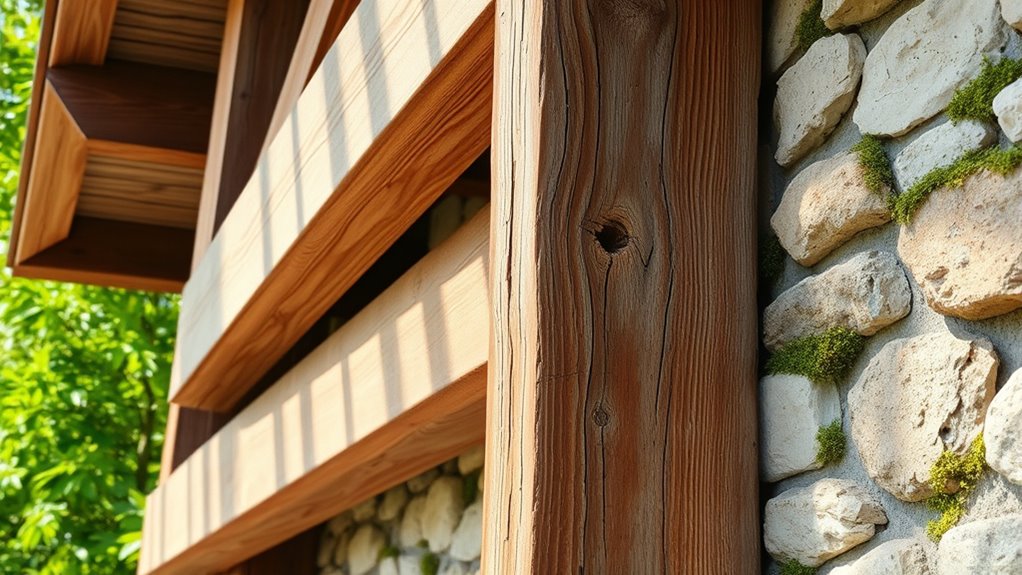Natural materials like wood, leather, and stone age gracefully, developing unique character and beauty over time. Wood’s grain becomes more prominent, and its color deepens with age, while leather develops a rich patina full of personality. Stone may reveal subtle cracks and a gentle patina, adding rustic charm. These materials become more authentic and attractive, telling a story of life and care. Keep exploring to discover how embracing natural aging enhances their timeless appeal.
Key Takeaways
- Wood naturally develops a rich patina, deepening in color and grain over time.
- Leather ages beautifully, acquiring a unique patina, cracks, and wrinkles that add character.
- Stone surfaces subtly change with age, gaining a rustic patina and gentle variations.
- Natural materials like cork and bamboo soften and develop unique markings with use.
- These materials become more beautiful and valuable, embodying history and authenticity as they age.

Natural materials have been used by humans for centuries, offering sustainable and eco-friendly alternatives to synthetic products. They carry a timeless appeal that only improves as they age, developing character and beauty over time. When you choose natural materials like wood, leather, or stone, you’re opting for products that tell a story through their evolving appearance. These materials aren’t just durable; they’re designed to age gracefully, becoming more attractive with each passing year. Unlike their synthetic counterparts, natural materials often develop a patina or a unique wear pattern that adds depth and personality to your belongings.
Natural materials age beautifully, gaining character and charm over time.
Wood, for example, is one of the most classic natural materials that age beautifully. Over time, it softens, with scratches and dents transforming into part of its character rather than flaws. The grain may become more prominent, and the color can deepen, giving each piece a distinct personality. Whether it’s furniture, flooring, or decor, wood’s natural aging process creates a warm, inviting ambiance that can’t be replicated with manufactured materials. Leather also shares this trait. As it ages, it develops a rich, supple patina that highlights its history and use. Cracks and wrinkles become part of its charm, showing that it’s been loved and cared for over the years. Proper maintenance allows leather to mature gracefully, becoming softer and more luxurious with time.
Stone is another natural material that ages beautifully. Its surface may develop subtle variations, tiny cracks, or even a gentle patina from exposure to the environment. These changes enhance its rustic appeal and offer a sense of authenticity that synthetic surfaces simply can’t match. The more you care for and clean stone, the more its natural texture and color variations shine through, giving your space a timeless, elegant look. Clay and terracotta also age well, developing a matte finish and a softer hue that signals their age with understated grace. Natural aging processes ensure these materials become more charming and valuable over time.
Choosing natural materials means investing in items that grow more beautiful over time, reflecting your life’s journey and stories. They offer not only sustainability but also a sense of authenticity and charm that synthetic options struggle to match. When maintained properly, these materials become heirlooms, carrying the beauty of aging with dignity. They remind you that true elegance isn’t about perfection but about character, history, and the natural process of aging. In embracing natural materials, you’re opting for products that truly stand the test of time, becoming more enchanting and meaningful as the years pass.
Frequently Asked Questions
How Can I Prevent Natural Materials From Deteriorating Over Time?
To prevent natural materials from deteriorating over time, you should regularly clean and maintain them, avoiding excessive moisture and direct sunlight. Use protective treatments like oils or sealants suited for each material, and guarantee proper ventilation in storage areas. Handle them gently to minimize damage, and perform periodic inspections to identify early signs of wear or decay. These steps help preserve their beauty and integrity over the years.
Are Natural Materials Suitable for Outdoor Use?
Yes, natural materials can be suitable for outdoor use if you choose the right ones and properly maintain them. For example, teak, cedar, and stone resist weathering well, especially when treated or sealed. You should regularly clean, reapply protective finishes, and shield your materials from excessive moisture and sun exposure. Doing so helps your natural materials age gracefully and retain their beauty, even in challenging outdoor environments.
Do Natural Materials Require Special Maintenance or Treatments?
Natural materials often need a bit of TLC to keep their charm. Think of it like caring for a beloved garden—regular watering, trimming, and occasional fertilizing help it thrive. You might need to seal wood to prevent cracking or treat stone to resist stains. With proper maintenance, your natural materials will age beautifully, developing character over time, much like a well-loved piece of furniture that tells its story.
How Do Natural Materials Compare Environmentally to Synthetic Options?
You’ll find natural materials generally more eco-friendly than synthetics because they’re renewable, biodegradable, and often produced with less energy. They typically have a smaller carbon footprint and don’t release harmful chemicals. While some synthetic options might last longer or be more resistant, natural materials promote sustainability and reduce environmental impact. By choosing natural options, you’re supporting greener practices and helping preserve the planet for future generations.
Can Natural Materials Be Recycled or Repurposed After Aging?
Yes, natural materials can often be recycled or repurposed after aging. You might find that wood, leather, and stone can be repurposed into new furniture or art pieces, extending their life and reducing waste. Many natural fibers, like cotton or wool, can be recycled into new textiles. By caring for and creatively reusing these materials, you help promote sustainability and give them a second, meaningful life.
Conclusion
So, when you choose natural materials, you’re not just opting for beauty and durability—you’re embracing timeless elegance that outshines even the most glamorous synthetic options. These materials age with grace, telling stories of years gone by and growing more charming with each passing day. Trust me, their resilience is so extraordinary, it’s like they’ve unveiled the secret to eternal youth. By selecting natural, you’re investing in materials that will truly stand the test of time—more magnificent than any fleeting trend.









